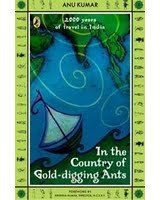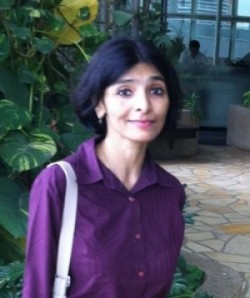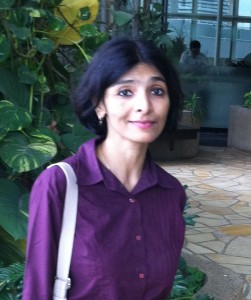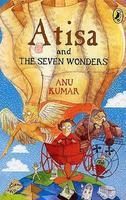Interview by Anupama Krishnakumar
Anu Kumar’s most recent novel, her third, is ‘It takes a murder’ (Hachette India). Her other two novels are ‘Letters for Paul’ (Mapinlit, 2006) and ‘The Dollmakers’ Island’ (Gyaana Books, 2010). She has written for older readers and also for children, and her stories have appeared in several magazines and newspapers. Her books for children include the ‘Atisa Series’, ‘The Chola Adventure’, ‘Chanakya : The Kingmaker and the Philosopher’, the ‘Mythquest Series’ and ‘In the Country of Gold Digging Ants’. Anu has won awards in the Commonwealth Short Story competition twice, for short fiction. To know more about Anu and her work, visit http://anukumar.org
To begin with, tell us what is it that fascinates you about writing for children?
That’s a hard question to begin with…actually, I am fairly certain am not thinking of who I am writing for when I am writing. Perhaps what I am hoping to aim for is to see the world through a younger person’s perspective when I am writing and that helps. The very many ways anything can be described, the inventive use of language, the process of discovery, all this comes alive in a different way.
What was the starting point that made you think that you should be doing this more often?
When I wrote ‘Atisa and the Seven Wonders’ (the first in the Atisa series), it just opened up the scope for several such adventures; all the possibilities of the ‘what ifs’ of history. The non-fiction book I did simultaneously, ‘In the Country of Gold-digging Ants’ (both published by Puffin Books) made me realise that there’s much that is fascinating about the past, that the material does exist and one has only to delve in to discover. It’s partly a process of finding out and imagining. I’ve had encouraging editors and the feedback from readers has always helped.
But also, it’s more than just about history; it’s learning about the powers of the imagination, and how as a writer, one can lead others into this journey of shared discovery where you trust in the imagination. Writing books for younger readers (or any reader, for that matter) is really that – it’s always a shared journey of discovery and new knowledge.
Who are the authors you really enjoyed reading as a child? What about each of their styles did you enjoy? Is there anything about their craft/technique in particular that you make sure is part of your writing style?
I hate to begin an answer with ‘too many to recall’ but yes we were honed into the classics of English literature when still young. There was Charles Dickens’ A Tale of Two Cities’ with its vast ambition and sense of drama, and also the Dumas’ novels of ‘The Three Musketeers’ and its sequels, and ‘The Count of Monte Cristo’. I also remember the stories of Satyajit Ray and Leela Majumdar replete with bizarre, very believable adventures, some very clever humour and the lovable quaintness of everyday characters, which is what I particularly remember of Leela Majumdar’s stories. When I was reading these of course, it wasn’t with the intention, even subconsciously, that one day I would write too. The very thought then and even now would have struck me as audacious. But there’s the ability to create a different world, believable in every way that every writer might want to emulate.
You write for adults as well. How easy or difficult is it for you to make the transition in terms of writing style when you are out from writing an adults book and move to writing a children’s book (or vice versa)? How do you tackle it?
Probably this is easier said than done. When I am working on, say, one of the Atisa books, it’s that I am seeing his world – the world from Atisa’s eyes. And a similar thing worked when I wrote ‘It Takes a Murder’ (Hachette 2012), which is one for older readers. It’s a book that is both literary fiction and a murder story. It isn’t that a book for older readers has to have more violence, more gory or other romantic details. Essentially, it’s always the narrator, the main narrator, who decides things. The narrator leads the writer and never the other way around.
When you write children’s books, how much and what kind of research do you do?
Quite a lot. Obviously for the non-fiction books, I do a lot of detailed reading and this was necessary for say, a book like ‘In the Country of Gold-Digging Ants’ and even its sequel that is due next year. The Myth Quest books too involved reading up on what the different texts, the Puranas for instance, in their translation, had to say about specific beings, and so on. The Atisa books are a mix of fact and fiction, and it’s amazing the kind of thinking that I realised was required to balance the elements of fiction with the historical facts I had to use.
Of the books that you have written for children, which one is your favourite? Why?
All. But I love the historical and the history-related writing – fiction and non-fiction that I’ve had to do.
But if you ask me to choose, it’d be the Atisa books, the three that have appeared, the others due and the still others that are possible. The ‘what ifs’, the so many questions left unanswered by recorded history, the many marginal characters in history whose stories have never been told, all these fascinate me. Atisa hasn’t even travelled half that distance into the past, he could though.
Today the internet and digital publishing as well as the print publishing spaces are full of children’s literature of all sorts. Unfortunately, quality does take a hit. What do you think are the defining characteristics of good children’s literature?
Something that makes them fall deep into the story, sink into it totally. A story that has them all intrigued and curious. Something that makes them want to discover, feel the joy in the world and all that it has to offer. A book that does not talk down to them. I respect the intelligence of younger readers, and its an age when they love to be challenged.
But this does not mean that one writes in an abstruse way, but you write in a way that you trust your reader and the latter in turn lets her guard down and enters your imagination.
How do you think the reader can cut through the clutter and identify the true gems?
That’s too easy to wish for and if there were ready answers, I guess publishing for younger readers would be thriving. I can only try and think up answers. I gather publishing for a younger readership is in some ways different. Why books from elsewhere (the US or even the UK) have a headstart is because of the digital and electronic reach their books have – so readers in essence are made ‘aware’ of these books and their authors much before. So publishers and editors and writers here need to have a vivid internet presence, not just to market themselves but also because that is how the bond between writers and readers is first created. It’s a digital dialogue that must work as a model, I think.
There are some lovely websites and blogs that review books consistently : saffrontree and young India books, for instance. Readers can access these as well as the Hindu’s Young World that features stories and reviews. Further, publishers like Pratham for instance actually reach out to schools and their readers; more book events by authors at local libraries and schools will help everyone too. So I think more of such inititatives in every possible way.
What do you believe are some great ways to inculcate the reading habit in children and make reading fun for them?
Reading to, and with children is always a fun thing to do, and soon it becomes an everyday thing to do. I remember my daughter watched the lovely Little Krishna episodes on Youtube first and then she wanted the stories read to her. That’s not a bad thing then!
Lastly, we would love to have your recommended must-read reading list for children.
- Ekkori’s Dream by Mahasweta Devi
- The Kaziranga Trail by Arup Kumar Dutta (also his others such as The Lure of Zangrila)
- Abol Tabol by Sukumar Ray
- The Unicorn expedition and other stories by Satyajit Ray
- The Harry Potter series by J.K. Rowling
- Swami and Friends and the other Malgudi books by R.K.Narayan. Also his Ramayana and the Mahabharata.
- Works of Charles Dickens, Alexandre Dumas, Jane Austen, Jules Verne and Gulliver’s Travels by Jonathan Swift and Alice in Wonderland by Lewis Carroll
- The Graveyard Book by Neil Gaiman (don’t go by the title!)
- The Children of the New Forest by C F Marryat
- Night on the Galactic Railroad by Kenji Miyazawa
- The William books by Richmal Crompton
- Comet in Moominland (and others in the series) by Tove Jansson
- Tales from Shakespeare – Charles and Mary Lamb (there’s no better introduction to Shakespeare than this book!)







